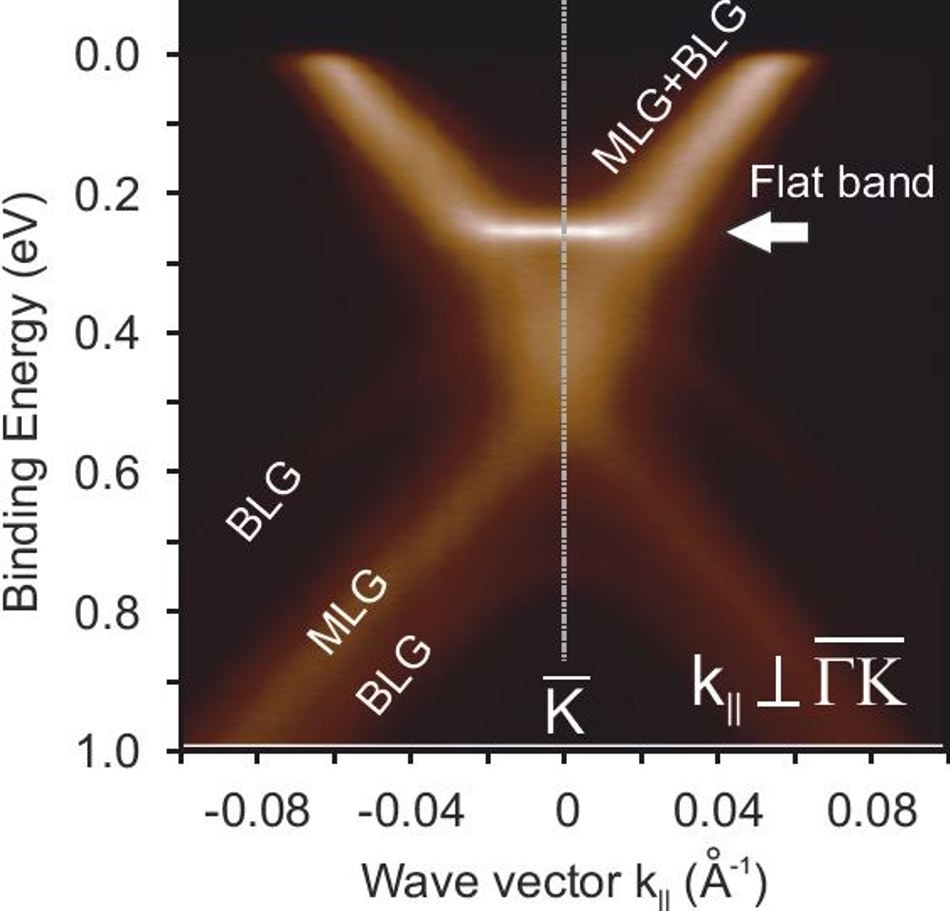Nov 12 2018
Researchers from HZB have discovered that double layers of graphene have a property that might enable them conduct current without any resistance. They investigated the bandstructure at BESSY II using very high resolution ARPES and were able detect a flat area at an astonishing location.
 The data show, in the case of the two-layer graphene, a flat part of bandstructure only 200 meV volts below the Fermi energy. (Image credit: HZB)
The data show, in the case of the two-layer graphene, a flat part of bandstructure only 200 meV volts below the Fermi energy. (Image credit: HZB)
Carbon atoms have a range of possibilities to form bonds. Hence, pure carbon can exist in various forms, such as graphite, diamond, as nanotubes, football molecules or as a honeycomb-net with hexagonal meshes, graphene. Although this peculiar, strictly two-dimensional material is an excellent conductor of electricity, it is not a superconductor. However, possibilities are that this can be altered.
A complicated option for superconductivity
In April 2018, a team of researchers from MIT, USA, demonstrated that a form of superconductivity can be generated in a system consisting of two graphene layers under highly particular conditions: In order to achieve this, it is necessary to twist the two hexagonal nets against each other precisely at the magic angle of 1.1°. A flat band develops in the electronic structure under this condition. It is complicated to prepare samples from two graphene layers with such a precisely adjusted twist and not appropriate for mass production. However, the research has gained a lot of attention among experts.
The simple way to flat bands
However, there is one more, considerably simpler method for forming flat band. This was demonstrated by a team at the HZB around Professor Oliver Rader and Dr Andrei Varykhalov with investigations at BESSY II. Professor Thomas Seyller, TU Chemnitz, offered the samples. They are developed by means of a process that is also appropriate for the production of larger areas and in large quantities: A silicon carbide crystal is heated to the point where silicon atoms evaporate from the surface, initially leaving behind a single graphene layer on the surface, and subsequently a second graphene layer. The two graphene layers are not twisted against each other; in contrast, they lie exactly on top of one another.
Scanning the band structure with ARPES
At BESSY II, the physicists were able to scan the purported band structure of the sample, which offers information related to the way charge carriers are distributed among the quantum-mechanically permitted states and which charge carriers are available for transport at all. The angle-resolved photoemission spectroscopy (ARPES) at BESSY II allows such measurements to be performed at exceptionally high resolution.
An interesting region under scrutiny
Through a precise analysis of the band structure, they detected an area that had been overlooked earlier.
The double layer of graphene has been studied before because it is a semiconductor with a band gap. But on the ARPES instrument at BESSY II, the resolution is high enough to recognize the flat area next to this band gap.
Dr Andrei Varykhalov, HZB
It is an overseen property of a well-studied system. It was previously unknown that there is a flat area in the band structure in such a simple well-known system.
Dr Dmitry Marchenko, Study First Author, HZB
Superconductivity? Needs still a little help
This flat area is a essential for superconductivity only if it is located precisely at the purported Fermi energy. The energy level of the two-layer graphene is only 200 meV below the Fermi energy; however, the energy level of the flat area can be increased to the Fermi energy either by doping with foreign atoms or by the application of an external voltage, the so-called gate voltage.
The physicists have discovered that the interactions between the two layers of graphene and between graphene and the silicon carbide lattice are collectively responsible for the formation of the flat band area. “We can predict this behavior with very few parameters and could use this mechanism to control the band structure,” added Oliver Rader.